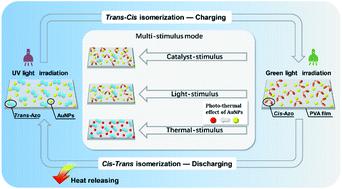当前位置:
X-MOL 学术
›
J. Mater. Chem. A
›
论文详情
Our official English website, www.x-mol.net, welcomes your feedback! (Note: you will need to create a separate account there.)
Azobenzene-based solar thermal energy storage enhanced by gold nanoparticles for rapid, optically-triggered heat release at room temperature
Journal of Materials Chemistry A ( IF 11.9 ) Pub Date : 2020-08-05 , DOI: 10.1039/d0ta06913b Liqi Dong 1, 2, 3, 4 , Yuanhao Chen 1, 2, 3, 4 , Fei Zhai 1, 2, 3, 4 , Lin Tang 1, 2, 3, 4 , Wenchao Gao 1, 2, 3, 4 , Junwen Tang 1, 2, 3, 4 , Yiyu Feng 1, 2, 3, 4 , Wei Feng 1, 2, 3, 4, 5
Journal of Materials Chemistry A ( IF 11.9 ) Pub Date : 2020-08-05 , DOI: 10.1039/d0ta06913b Liqi Dong 1, 2, 3, 4 , Yuanhao Chen 1, 2, 3, 4 , Fei Zhai 1, 2, 3, 4 , Lin Tang 1, 2, 3, 4 , Wenchao Gao 1, 2, 3, 4 , Junwen Tang 1, 2, 3, 4 , Yiyu Feng 1, 2, 3, 4 , Wei Feng 1, 2, 3, 4, 5
Affiliation

|
Solar thermal fuel (STF) technology based on azobenzene (Azo) compounds represents a novel approach for the capture, conversion, and storage of solar energy. Azos can store energy by isomerization between their thermodynamically stable trans-isomers and higher energy, metastable cis-isomers. The energy barrier to Azo isomerization must be overcome in order to store and release energy using these materials. Generally, this is achieved using heat, light, or catalysis. Heating is the most frequently used strategy to overcome the energy barrier and release the stored energy in Azo-based STFs (Azo-STFs). However, heating Azos is not economical in practical STF applications. A notable target is the development of strategies for the construction of STFs that operate at room temperature. In this study, polyvinyl alcohol (PVA) polymer-templated, gold nanoparticle (AuNP) doped, 1,3,5-tris(arylazo)benzene (tri-Azo)-based STFs (PVA/Azo@AuNP STFs) are presented. The heat storage and release behavior of these composites can be controlled completely using light alone at room temperature. Light at a wavelength of 365 nm is effective for charging the PVA/Azo@AuNP STFs, while light at 520 nm induces the release of energy from the samples. Temperature increases of up to 8.8 °C were observed during the discharge of the PVA/Azo@AuNP STFs. The significant heat output can be attributed to three cooperative effects. First, irradiation at 520 nm irradiation triggers cis-to-trans isomerization of tri-Azo. Second, light irradiation at 520 nm stimulates the plasmonic photothermal effect in the AuNPs, releasing heat, which stimulates the cis-to-trans isomerization reaction. Finally, the AuNPs act as catalysts, accelerating the cis-to-trans isomerization reaction. Through these multiple stimulation modes, heat is released rapidly from the charged PVA/Azo@AuNP STFs. The mechanism and design principles for such novel Azo-STFs are discussed. This work provides a new strategy for the design of efficient Azo-STFs that operate at room temperature.
中文翻译:

金纳米颗粒增强了基于偶氮苯的太阳能热能存储,可在室温下通过光触发快速释放热量
基于偶氮苯(Azo)化合物的太阳能热燃料(STF)技术代表了一种捕获,转化和储存太阳能的新颖方法。Azos可以通过其热力学稳定的反式异构体与较高能的亚稳态顺式异构体之间的异构化来存储能量-异构体。为了使用这些材料存储和释放能量,必须克服偶氮异构化的能垒。通常,这是使用热,光或催化来实现的。加热是克服能垒并释放基于偶氮的STF(Azo-STF)中存储的能量的最常用策略。但是,在实际的STF应用中加热Azos并不经济。一个值得注意的目标是开发在室温下运行的STF的策略。在这项研究中,提出了以聚乙烯醇(PVA)为聚合物模板的金纳米颗粒(AuNP)掺杂的1,3,5-三(芳基偶氮)苯(tri-Azo)基STF(PVA / Azo @ AuNP STF)。这些复合材料的储热和释放行为可以在室温下仅使用光即可完全控制。波长为365 nm的光可有效为PVA / Azo @ AuNP STF充电,而波长为520 nm的光则可诱导样品释放能量。在PVA / Azo @ AuNP STF放电期间,观察到温度升高到8.8°C。大量的热量输出可归因于三个协同效应。首先,在520 nm的照射下触发顺至-反式三偶氮的异构化。第二,在520纳米的光照射刺激在金纳米粒子的等离激元光热效应,释放出热量,刺激顺-到-反式异构化反应。最后,金纳米粒子作为催化剂,加速了顺至-反式异构化反应。通过这些多种刺激模式,热量迅速从带电的PVA / Azo @ AuNP STF中释放出来。讨论了这种新颖的Azo-STF的机理和设计原理。这项工作为设计在室温下工作的高效Azo-STF提供了新的策略。
更新日期:2020-09-22
中文翻译:

金纳米颗粒增强了基于偶氮苯的太阳能热能存储,可在室温下通过光触发快速释放热量
基于偶氮苯(Azo)化合物的太阳能热燃料(STF)技术代表了一种捕获,转化和储存太阳能的新颖方法。Azos可以通过其热力学稳定的反式异构体与较高能的亚稳态顺式异构体之间的异构化来存储能量-异构体。为了使用这些材料存储和释放能量,必须克服偶氮异构化的能垒。通常,这是使用热,光或催化来实现的。加热是克服能垒并释放基于偶氮的STF(Azo-STF)中存储的能量的最常用策略。但是,在实际的STF应用中加热Azos并不经济。一个值得注意的目标是开发在室温下运行的STF的策略。在这项研究中,提出了以聚乙烯醇(PVA)为聚合物模板的金纳米颗粒(AuNP)掺杂的1,3,5-三(芳基偶氮)苯(tri-Azo)基STF(PVA / Azo @ AuNP STF)。这些复合材料的储热和释放行为可以在室温下仅使用光即可完全控制。波长为365 nm的光可有效为PVA / Azo @ AuNP STF充电,而波长为520 nm的光则可诱导样品释放能量。在PVA / Azo @ AuNP STF放电期间,观察到温度升高到8.8°C。大量的热量输出可归因于三个协同效应。首先,在520 nm的照射下触发顺至-反式三偶氮的异构化。第二,在520纳米的光照射刺激在金纳米粒子的等离激元光热效应,释放出热量,刺激顺-到-反式异构化反应。最后,金纳米粒子作为催化剂,加速了顺至-反式异构化反应。通过这些多种刺激模式,热量迅速从带电的PVA / Azo @ AuNP STF中释放出来。讨论了这种新颖的Azo-STF的机理和设计原理。这项工作为设计在室温下工作的高效Azo-STF提供了新的策略。



























 京公网安备 11010802027423号
京公网安备 11010802027423号